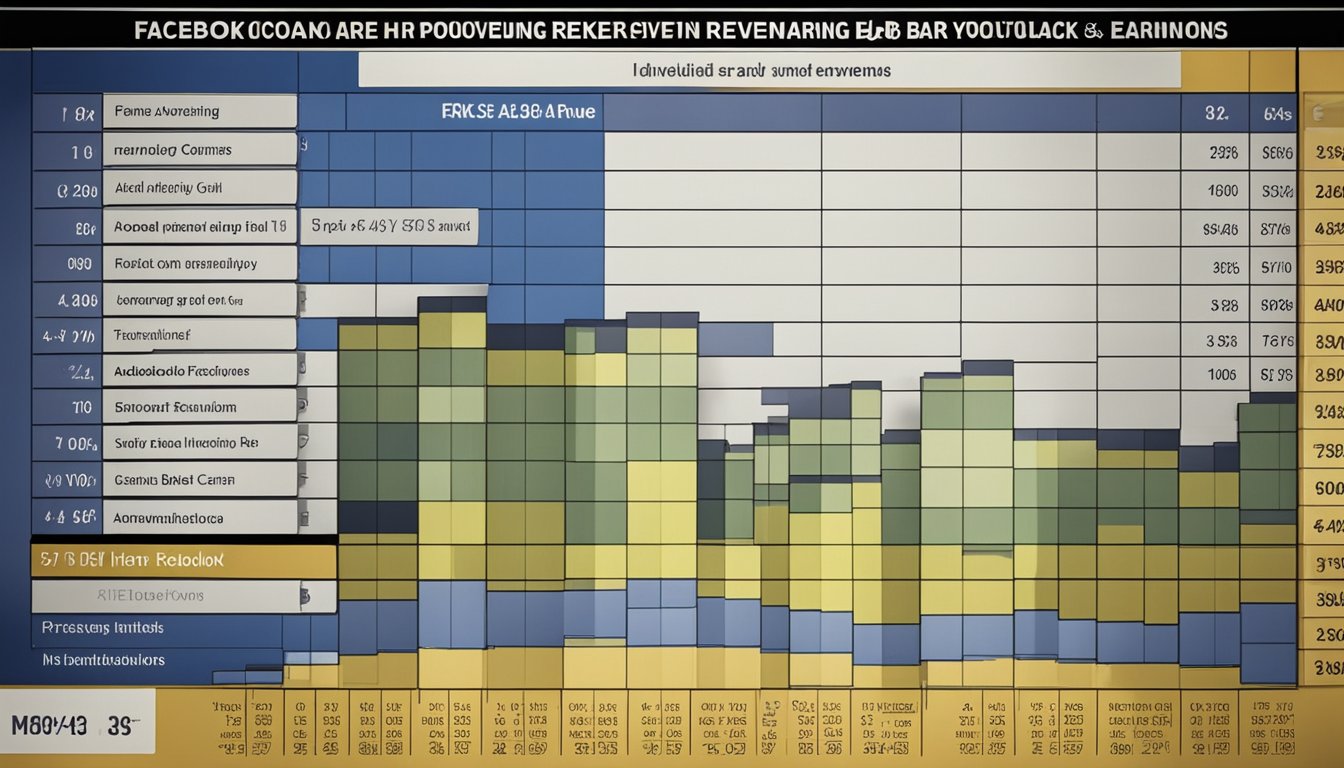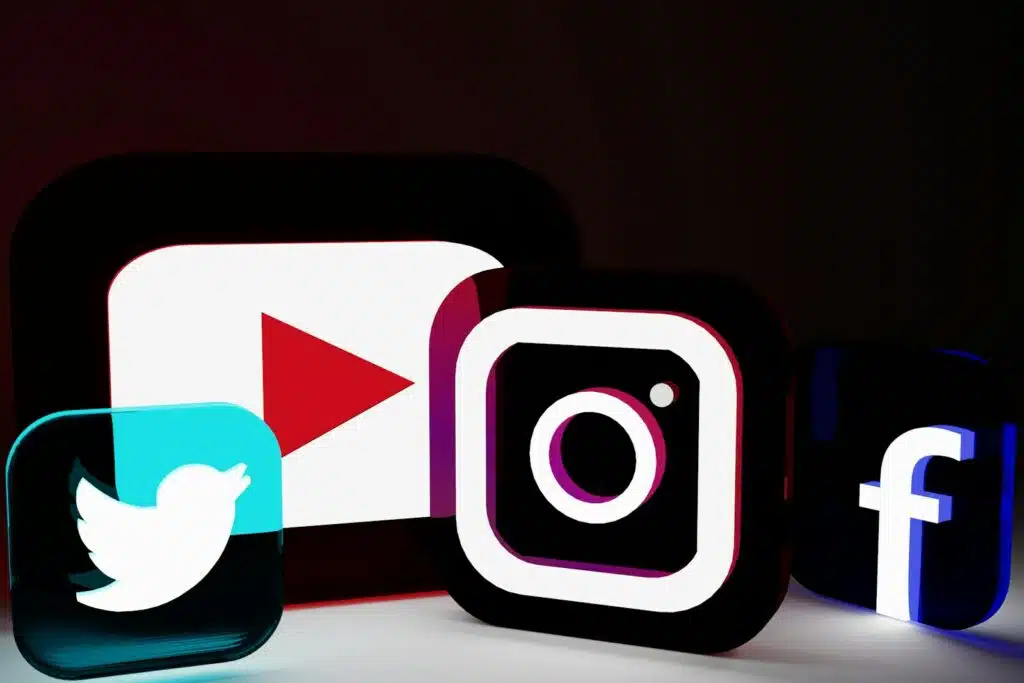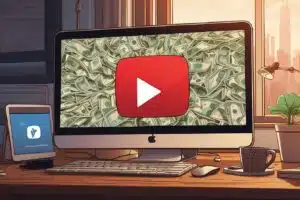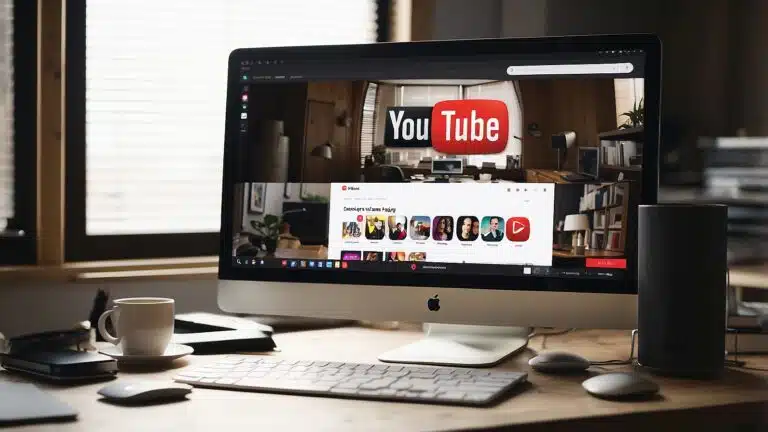If you're a content creator looking to monetize your videos, you may be wondering which platform is better for earnings: Facebook or YouTube. Both social media giants offer opportunities for creators to earn money from their content, but which one is more lucrative? In this article, we'll take a look at Facebook vs YouTube earnings, user engagement, advertising and revenue strategies, and more to help you determine which platform is right for you.

First, let's take a brief overview of Facebook and YouTube. Facebook is a social media platform that allows users to connect with friends and family, join groups, and share content. YouTube, on the other hand, is a video-sharing platform that allows users to upload and watch videos on a wide range of topics. While both platforms have similarities, they differ in terms of their primary functions and user demographics.
When it comes to content creation and distribution, Facebook and YouTube have different approaches. Facebook's video content is primarily distributed through the News Feed, while YouTube's content is organized into channels and searchable through its algorithm. Despite these differences, both platforms offer monetization options for creators, including ads, sponsorships, and fan support. In the next section, we'll dive deeper into each platform's earning mechanisms.
Key Takeaways
- Facebook and YouTube both offer monetization options for creators, including ads, sponsorships, and fan support.
- YouTube generally offers higher earnings potential for creators due to its larger user base and higher CPM rates.
- When choosing between Facebook and YouTube for monetization, consider your content type, audience demographics, and personal goals.
Overview of Facebook vs YouTube Earnings
Historical Earnings Comparison
Facebook and YouTube are two of the largest social media platforms in the world, with billions of monthly active users. Both platforms offer content creators the opportunity to monetize their content and earn revenue. However, historical earnings comparison between Facebook and YouTube shows that YouTube has been the more lucrative platform for content creators. As of 2022, YouTube has paid out over $30 billion to content creators, while Facebook has paid out $1 billion to creators in 2021 alone. This is largely due to the fact that YouTube has a more established monetization model and a larger audience.
Monetization Models
Both Facebook and YouTube offer content creators the ability to monetize their content through ad revenue. However, there are some differences in their monetization models. YouTube's monetization model is based on the number of views and engagement a video receives. Creators can earn revenue through ads that are displayed on their videos, as well as through sponsorships, merchandise sales, and fan funding. Facebook's monetization model is based on the number of minutes viewed by users. Creators can earn revenue through ads that are displayed in their videos, as well as through fan subscriptions and stars.
While both platforms offer content creators the ability to monetize their content, YouTube's monetization model is generally considered to be more lucrative due to its established ad revenue system and larger audience. Additionally, YouTube offers more opportunities for creators to earn revenue through sponsorships, merchandise sales, and fan funding.
In terms of revenue, both Facebook and YouTube generate significant amounts of ad revenue. In 2021, Facebook generated over $84 billion in ad revenue, while YouTube generated over $19.7 billion in ad revenue. However, it is important to note that Facebook's revenue is not solely from video ads, as the platform also offers other types of ads such as display ads and sponsored posts.
Overall, while both Facebook and YouTube offer content creators the ability to monetize their content, YouTube's established monetization model and larger audience make it the more lucrative platform for content creators.
Content Creation and Distribution

Creating content and distributing it on social media platforms is a crucial aspect of being a successful content creator. Both Facebook and YouTube provide creators with tools to create and publish content, but there are some differences in how they handle different content types and formats.
Content Types and Formats
YouTube is primarily known for video content, but it also supports other content formats such as live streaming, podcasts, and music. This allows creators to diversify their content and reach a wider audience. On the other hand, Facebook supports a variety of content formats including text, images, videos, and live streams. However, video content is more heavily promoted on Facebook, which means that creators who focus on video content may have an advantage on this platform.
Algorithm and Audience Reach
Both Facebook and YouTube use algorithms to determine which content to show to users. However, their algorithms are different, which means that the way content is promoted on each platform is different. YouTube's algorithm is primarily based on engagement metrics such as views, likes, and comments. This means that creators who create engaging content are more likely to be promoted on the platform.
Facebook's algorithm is more complex and takes into account factors such as engagement, relevance, and timeliness. This means that creators who create content that is relevant to their audience and posted at the right time are more likely to be promoted on the platform. Facebook's algorithm also takes into account autoplay, which means that videos that automatically play in users' feeds are more likely to be viewed.
In terms of audience reach, both platforms have a large user base, but YouTube has a more dedicated audience for video content. This means that creators who focus on video content may have a better chance of reaching a larger audience on YouTube. However, Facebook has a larger overall user base, which means that creators who focus on other content formats may have a better chance of reaching a larger audience on this platform.
Overall, both Facebook and YouTube provide creators with tools to create and distribute content. However, the way content is promoted on each platform is different, which means that creators need to tailor their content to each platform to maximize their reach and engagement.
Earning Mechanisms

When it comes to earning money on YouTube and Facebook, there are several mechanisms available to creators. In this section, we'll take a closer look at the most common methods of earning on these platforms.
Ad Revenue Sharing
Both YouTube and Facebook offer ad revenue sharing as a way for creators to earn money. On YouTube, creators can monetize their videos through the YouTube Partner Program (YPP). This program allows creators to earn money from ads that are displayed on their videos. YouTube shares a percentage of the revenue generated from these ads with the creator.
Similarly, Facebook offers ad revenue sharing to creators through its Facebook Creator Studio. Creators can monetize their videos by enabling in-stream ads. Facebook shares a percentage of the revenue generated from these ads with the creator.
Membership and Subscription Models
In addition to ad revenue sharing, both YouTube and Facebook offer membership and subscription models as a way for creators to earn money. On YouTube, creators can offer channel memberships to their viewers. This allows viewers to access exclusive content and perks in exchange for a monthly fee. YouTube takes a percentage of the revenue generated from these memberships.
Facebook offers a similar feature called "fan subscriptions." Creators can offer exclusive content, badges, and other perks to their subscribers in exchange for a monthly fee. Facebook takes a percentage of the revenue generated from these subscriptions.
Direct Support from Viewers
Finally, both YouTube and Facebook offer features that allow viewers to directly support their favorite creators. On YouTube, viewers can use Super Chat to make a donation during a live stream. Creators can also enable channel donations, which allow viewers to make one-time donations to support the channel.
Facebook offers a similar feature called "Stars." Viewers can purchase Stars and send them to creators during a live stream. Creators can then redeem these Stars for cash.
In conclusion, both YouTube and Facebook offer several mechanisms for creators to earn money. Ad revenue sharing, membership and subscription models, and direct support from viewers are all viable options for earning money on these platforms. As a creator, it's important to explore all of these options and find the ones that work best for you.
Creator and Publisher Support

Partner Programs
Both YouTube and Facebook offer partner programs to support creators and publishers. The YouTube Partner Program (YPP) and Facebook's Creator Studio are designed to help content creators monetize their content. To join these programs, creators must meet certain eligibility criteria, such as having a certain number of subscribers or views. Once accepted, creators can earn money through ad revenue, sponsorships, and other monetization methods.
The YPP is known for offering a more established and lucrative program compared to Facebook's Creator Studio. YouTube offers a higher revenue share to creators, with up to 55% of ad revenue going to the creator. Additionally, YouTube provides more tools and resources for creators to grow their channels, including analytics, training, and access to a larger audience.
Creator Funds and Grants
Both platforms offer creator funds and grants to support creators and publishers. YouTube's Creator Fund provides financial support to creators who are building their channels and audience. The fund provides grants to creators who meet certain criteria, such as having a certain number of subscribers or views. Facebook also offers a similar program, called the Creator Fund, which provides financial support to creators who create content for Facebook and Instagram.
However, YouTube's Creator Fund is more established and offers larger grants compared to Facebook's Creator Fund. YouTube's Creator Fund has provided millions of dollars in funding to creators since its inception, while Facebook's Creator Fund is still in its early stages.
In conclusion, both YouTube and Facebook offer support to creators and publishers through their partner programs and creator funds. However, YouTube's YPP and Creator Fund are more established and offer more lucrative opportunities for creators.
User Engagement and Growth

Engagement Metrics
When it comes to engagement metrics, both Facebook and YouTube offer insights to creators to help them understand how their audience interacts with their content. Facebook provides engagement metrics such as likes, comments, and shares, while YouTube offers metrics such as likes, dislikes, comments, and shares.
Engagement rate is an important metric for both platforms. It measures the level of interaction between the audience and the content. According to a report by Statista, the average engagement rate on YouTube is 4.5%, while on Facebook it is 0.18%. This indicates that YouTube has a higher level of audience engagement compared to Facebook.
Followers and Subscribers
Followers and subscribers are important indicators of growth on both platforms. On Facebook, users can follow a page, while on YouTube users can subscribe to a channel. According to a report by Vox, Facebook has over 2.8 billion monthly active users, while YouTube has over 2.1 billion monthly active users.
In terms of followers and subscribers, YouTube has a higher number of subscribers compared to Facebook pages. For instance, the most subscribed YouTube channel, T-Series, has over 190 million subscribers, while the most followed Facebook page, Facebook for Creators, has over 1.5 million followers.
Audience retention rate is another important metric for measuring engagement on both platforms. It measures the percentage of viewers who watch a video or live stream until the end. According to a report by VeeFly, the average audience retention rate on YouTube is 50-60%, while on Facebook it is 25-30%. This indicates that YouTube has a higher level of audience engagement and retention compared to Facebook.
Overall, while both Facebook and YouTube offer engagement metrics and growth opportunities to creators, YouTube seems to have a higher level of audience engagement and retention compared to Facebook.
Advertising and Revenue Strategies

When it comes to advertising and revenue strategies, both Facebook and YouTube offer different options for creators to monetize their content. Here are some of the key differences between the two platforms.
Ad Placement and Targeting
Facebook and YouTube both offer different ad placement options for creators. On Facebook, ads can appear in the middle of videos, as well as in the News Feed and Stories. On YouTube, ads can appear before, during, or after videos, as well as in the sidebar and search results.
In terms of targeting, Facebook has a more advanced targeting system, which allows advertisers to target users based on their interests, behaviors, and demographics. YouTube also offers targeting options, but they are not as granular as Facebook's.
CPM and Revenue Optimization
CPM, or cost per thousand impressions, is a metric used to measure how much advertisers pay for every thousand ad views. Both Facebook and YouTube use CPM to determine how much creators earn from their ad revenue.
However, the CPM rates on Facebook and YouTube can vary widely depending on the type of content and audience. According to Veefly, YouTube videos can generate over $2000, while earning $260-$350 from Facebook. While Facebook has a larger audience, YouTube has higher CPM rates, which can result in more revenue for creators.
To optimize your revenue on both platforms, it's important to create high-quality content that appeals to your target audience. You should also experiment with different ad formats and placements to see which ones work best for your content. Additionally, building a strong following and engaging with your audience can help increase your ad revenue over time.
In conclusion, both Facebook and YouTube offer different options for creators to monetize their content. By understanding the differences in ad placement, targeting, and CPM rates, you can optimize your revenue on both platforms and build a successful career as a content creator.
Competitive Landscape

When it comes to online video and social media platforms, YouTube and Facebook are two of the biggest players in the game. However, they are not the only players in the field. Let's take a closer look at the competitive landscape surrounding these two giants.
Comparison with Other Social Platforms
Other social media platforms like Instagram and TikTok have also entered the video content game. Instagram's IGTV and TikTok's short-form videos have become increasingly popular among younger audiences. However, they are not yet as established as YouTube and Facebook in terms of monetizing content and providing significant earnings to creators.
Market Share and Industry Impact
According to a report by eMarketer, YouTube's market share of the digital video ad industry in the US is expected to decline from 20.5% in 2020 to 16.4% in 2022. Meanwhile, Facebook's market share is expected to increase from 24.5% to 26.3% in the same period. This indicates that Facebook is gaining ground in the digital video ad space and could pose a greater threat to YouTube's dominance in the future.
In addition, the competition between YouTube and Facebook has also led to changes in the industry. For example, YouTube has had to adapt to the rise of short-form video content by launching YouTube Shorts. Meanwhile, Facebook has been investing heavily in its video content and creator ecosystem, with plans to pay creators $1 billion in total through 2022.
It is worth noting that the competitive landscape is not limited to social media platforms. China's video-sharing app, TikTok, has become a major player in the industry, with over 1 billion monthly active users. However, TikTok's future in the US remains uncertain due to ongoing legal challenges and concerns about data privacy.
Overall, the competitive landscape surrounding YouTube and Facebook is constantly evolving. It is important for creators to stay up-to-date with industry trends and changes in order to stay sustainable and successful in the long run.
Challenges and Considerations

When comparing Facebook and YouTube earnings, it's important to consider the challenges and potential issues that come with each platform. Here are some factors to keep in mind:
Legal and Regulatory Issues
Both Facebook and YouTube are subject to laws and regulations that can impact earnings potential. For example, YouTube has faced criticism and legal action over copyright infringement, which can result in demonetization or removal of videos. Similarly, Facebook has faced scrutiny over data privacy and content moderation. As a content creator, it's important to be aware of these issues and ensure that your content complies with the rules and regulations of the platform.
Data Usage and Privacy Concerns
Both Facebook and YouTube collect data from users, which can be used to target ads and inform content recommendations. However, this data collection has also raised concerns over privacy and data security. As a content creator, it's important to be aware of how your data is being used and take steps to protect your privacy. This may include adjusting your privacy settings, using a VPN, or being cautious about the information you share on the platform.
Overall, while both Facebook and YouTube offer opportunities for earnings, it's important to be aware of the challenges and considerations that come with each platform. By staying informed and taking steps to protect yourself, you can maximize your earnings potential while minimizing potential risks.
Future Outlook

Innovations in Monetization
Both Facebook and YouTube are constantly innovating their monetization strategies to attract more creators and provide better earning potential. One such innovation from Facebook is the introduction of in-stream ads for short-form videos, which allows creators to monetize their content in a way that was previously only available for longer videos. On the other hand, YouTube is experimenting with new ad formats such as interactive ads that allow viewers to engage with the content and purchase products directly from the video.
Another area where both platforms are innovating is in the realm of exclusive content. Facebook has introduced the Creator Studio, which allows creators to create and distribute exclusive content to their followers through a subscription model. Similarly, YouTube has launched YouTube Premium, which provides exclusive content to subscribers and allows creators to earn more revenue from their content.
Predictions for Creator Earnings
As both platforms continue to grow and attract more monthly active users, the earning potential for creators is only going to increase. According to a report by Statista, YouTube's advertising revenue was $19.8 billion in 2020, up from $15.1 billion in 2019. YouTube also offers a paid subscription service called YouTube Premium, which allows users to watch videos without ads and access exclusive content. It's estimated that YouTube Premium generated $3 billion in revenue in 2020.
Facebook is also expected to continue its growth trajectory, with the company reporting advertising revenue of $38.7 billion in Q4 2023. This growth is expected to continue as Facebook invests in new technologies such as virtual reality and augmented reality, which could provide new opportunities for creators to monetize their content.
Overall, the future looks bright for both Facebook and YouTube creators. With constant innovations in monetization strategies and an ever-growing user base, creators have more opportunities than ever before to earn a living from their creativity.



























